Manaslu Region Trek is one of Nepal’s most unique journeys, but unlike the Annapurna or Everest regions, it requires multiple permits. This is because Manaslu was declared a restricted area when it opened to foreign trekkers in 1992.
The main trek in the Manaslu region is the Manaslu Circuit, with variations that include the Tsum Valley. Our focus is on the circuit itself. Escape Himalaya offers three primary packages: the Manaslu Circuit Trek, the Manaslu Short Circuit Trek, and the Tsum Valley Trek.
Directing back to our agenda for today, The government created permit system to regulate entry into sensitive border regions with Tibet, to protect the cultural identity of local Nubri and Tsum communities, and to ensure tourism develops sustainably.
Manaslu Region permits play three key roles:
- Cultural preservation: They control the number of visitors in fragile villages and sacred sites.
- Border security: The route runs close to Tibet, and monitoring movement is essential.
- Sustainable tourism: Revenue from permits funds conservation, trail upkeep, and local development projects.
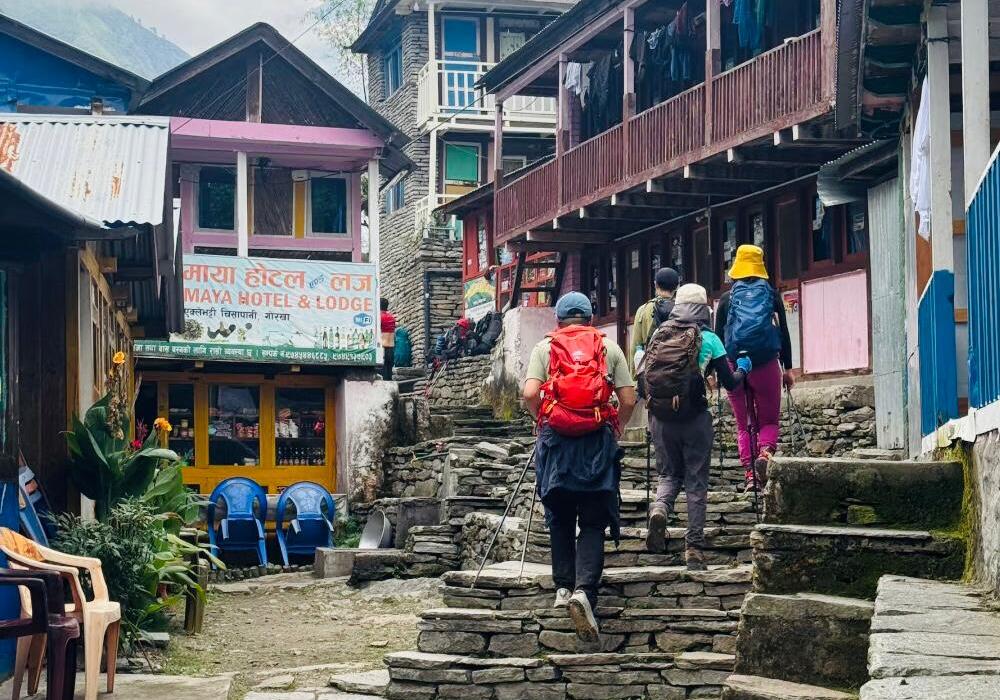
Types of Permits Needed
Trekkers primarily need three permits for the Manaslu Circuit:
- Manaslu Restricted Area Permit - MRAP - Allows entry between Jagat and Samagaun/Samdo.
- Manaslu Conservation Area Permit - MCAP - Covers trekking inside the Manaslu Conservation Area.
- Annapurna Conservation Area Permit - ACAP - Required when exiting through Dharapani into Annapurna.
Trekkers should also acquire these additional permits:
- Tsum Valley Restricted Permit: If extending your trek north into Tsum Valley.
- Chumnubri Rural Municipality Permit: A small local fee to support village infrastructure.
- TIMS Card: Not required if you have MRAP.
Many travel agencies offer different variations of the Manaslu trek, but our focus is on three main packages in the Manaslu region. For all of these, trekkers are required to obtain the permits outlined in the overview below.
| Trek Package | MCAP | MRAP | ACAP | TIMS | Tsum Valley Restricted | Chumnubri Rural Municipality |
|---|---|---|---|---|---|---|
| 14-day Manaslu Circuit Trek | ✔️ | ✔️ | ✔️ | ❌ | ✔️ | ✔️ |
| 9-day Manaslu Short Trek | ✔️ | ✔️ | ✔️ | ❌ | ✔️ | ✔️ |
| 20-day Tsum Valley Trek | ✔️ | ✔️ | ✔️ | ❌ | ✔️ | ✔️ |
When trekking in the Manaslu region, the TIMS card isn’t required, but other permits are essential. For the 14-day Manaslu Circuit, 9-day Short Trek, and 20-day Tsum Valley Trek, you’ll need the MCAP, MRAP, ACAP, Tsum Valley Restricted Permit, and Chumnubri Rural Municipality entry. With these in hand, you’re fully set to explore the region’s breathtaking trails without hassle.
At Escape Himalaya, we handle all trekking permits on your behalf, making the process completely hassle-free. This allows trekkers to focus on the journey ahead with comfort, confidence, and peace of mind.
Manaslu Restricted Area Permit (MRAP)
Areas covered: Jagat, Deng, Namrung, Samagaun, Samdo.
Cost:
The cost of the Manaslu Restricted Area Permit varies by season, with higher fees during the peak months of September to November. Trekkers should plan accordingly, as charges are calculated per day after the initial seven-day period.
| Nationality | September – November | December – August |
|---|---|---|
| Foreigners (incl. USA, UK, Australia, Europe) |
USD 100 for first 7 days + USD 15 per extra day | USD 75 for first 7 days + USD 10 per extra day |
| SAARC (incl. India) | Same as Foreigners | Same as Foreigners |
| Nepali Citizens | Not required | Not required |
Validity: Issued only for the days approved in your itinerary; extensions must be arranged in advance. If extension is desired, you must contant your travel agency.
Solo trekking ban: Solo trekking in the Manaslu region is strictly prohibited. The government requires at least two trekkers plus a licensed guide for every permit. This rule exists for safety, border security, and cultural protection. Immigration permit will not issue a Restricted Area Permit to a single traveler.
Group requirement: At least 2 trekkers must be listed on the permit application, plus a Nepal government-licensed guide.
Issuing authority: Department of Immigration, Kathmandu (via travel agencies).
What is the application process?
The process is handled entirely by your travel agency. DIY (Do it Yourself) trekkers cannot apply for the application process. This is how we conduct the application process:
- We submit all documents to the Department of Immigration in Kathmandu.
- Immigration reviews the paperwork and verifies details.
- The MRAP is issued with your name, passport number, itinerary dates, and validity clearly printed.
What documents are required?
To apply for the MRAP, you must provide the following documents to your travel agencies:
- Original passport with a valid Nepal visa
- Photocopies of your passport
- 2–4 recent passport-size photos
- Proof of travel insurance (must cover high altitude trekking and helicopter evacuation)
- A confirmed trekking itinerary prepared with your agency
How long does it take to issue the MRAP?
- In most cases, the permit is issued within a few hours if all documents are complete.
- During busy seasons or festival periods, it is best to allow at least one full working day in Kathmandu before departure to ensure everything is ready.
Special Notes from Escape Himalaya on the MRAP
Solo Trekkers
The government strictly prohibits solo trekking. To meet the requirement of two trekkers, agencies like ours may pair solo trekkers on paper with another traveler’s application. This allows an individual to join legally, but a licensed guide is still mandatory for the entire trek.
Licensed Guide Requirement
Only guides registered with the Nepal Tourism Board and Department of Tourism are eligible to lead treks in the restricted zone. Freelance or unregistered guides cannot process RAP applications, and trekkers attempting to bypass the system risk being stopped at Jagat.
Permit Validity and Overstay
The RAP is valid strictly for the dates listed on your application. If your trek runs longer than planned, you cannot extend it on the trail. For this reason, Escape Himalaya always advises clients to add 2–3 buffer days when applying, to cover delays caused by weather, acclimatization, or health.
Checkpoints and Verification
The RAP is strictly monitored. Officials at Jagat, Deng, Namrung, Samagaun, and Samdo will check and stamp the permit. Without a valid RAP, your trek will end at Jagat. We ensure all paperwork is complete so our clients pass through checkpoints without difficulty.
Children and Families
Children under 10 do not need to pay MRAP fees, but they must still be listed on the permit. Escape Himalaya helps families complete the paperwork correctly so minors can pass checkpoints smoothly.
Connection with Other Permits
A frequent misconception is that the RAP alone is enough. In reality, trekkers must also obtain MCAP and ACAP. We handle all three permits together to avoid last-minute complications.
Processing Time
We process the RAP directly with the Department of Immigration in Kathmandu. In most cases, the permit is issued within a few hours. However, during festival periods or peak trekking season, we recommend allowing at least one full working day before departure.
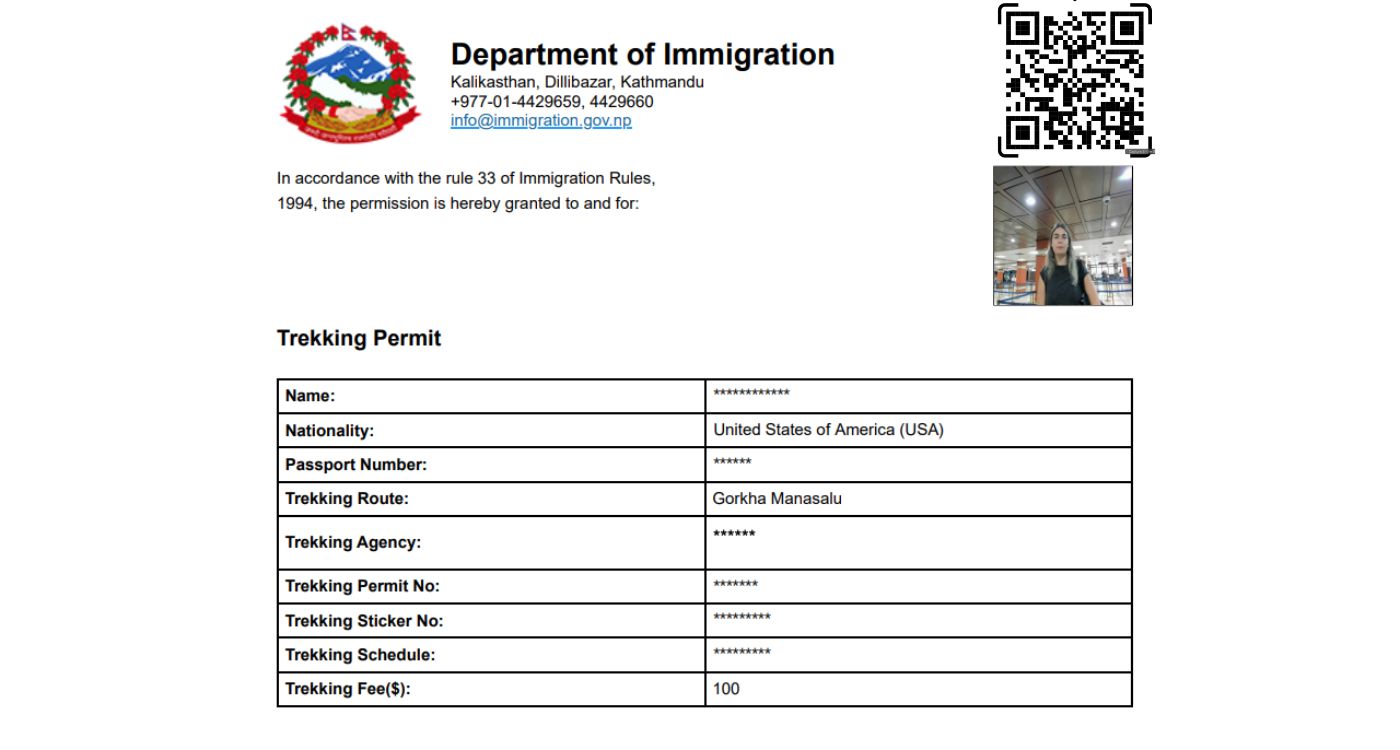
Manaslu Conservation Area Permit (MCAP)
What is the purpose of the MCAP?
The MCAP is designed to protect the Manaslu Conservation Area, which is home to rare wildlife, forests, rivers, and culturally significant villages. Permit fees fund conservation efforts, reforestation projects, trail upkeep, and local community development programs.
How much does the MCAP cost?
| Nationality | Fee |
|---|---|
| Foreigners | NPR 3,000 (USD 30) |
| SAARC Nationals | NPR 1,000 (USD 10) |
| Nepali Citizens | NPR 100 |
Is the fee seasonal?
No. The MCAP fee is a flat rate year-round and does not change between peak and off-peak seasons.
Who issues the MCAP?
The MCAP is issued by the Nepal Tourism Board (NTB) and the National Trust for Nature Conservation (NTNC). You can obtain it from NTB offices in Kathmandu or Pokhara.
What documents are required for the MCAP?
- Original passport and valid Nepal visa
- Passport photocopies
- 1–2 passport-size photos
- Basic trekking itinerary (your agency usually provides this)
How long does it take to get the MCAP?
The permit is normally issued within 30 minutes to 1 hour if all documents are complete. When arranged through a trekking agency, it is often ready on the same day alongside the RAP.
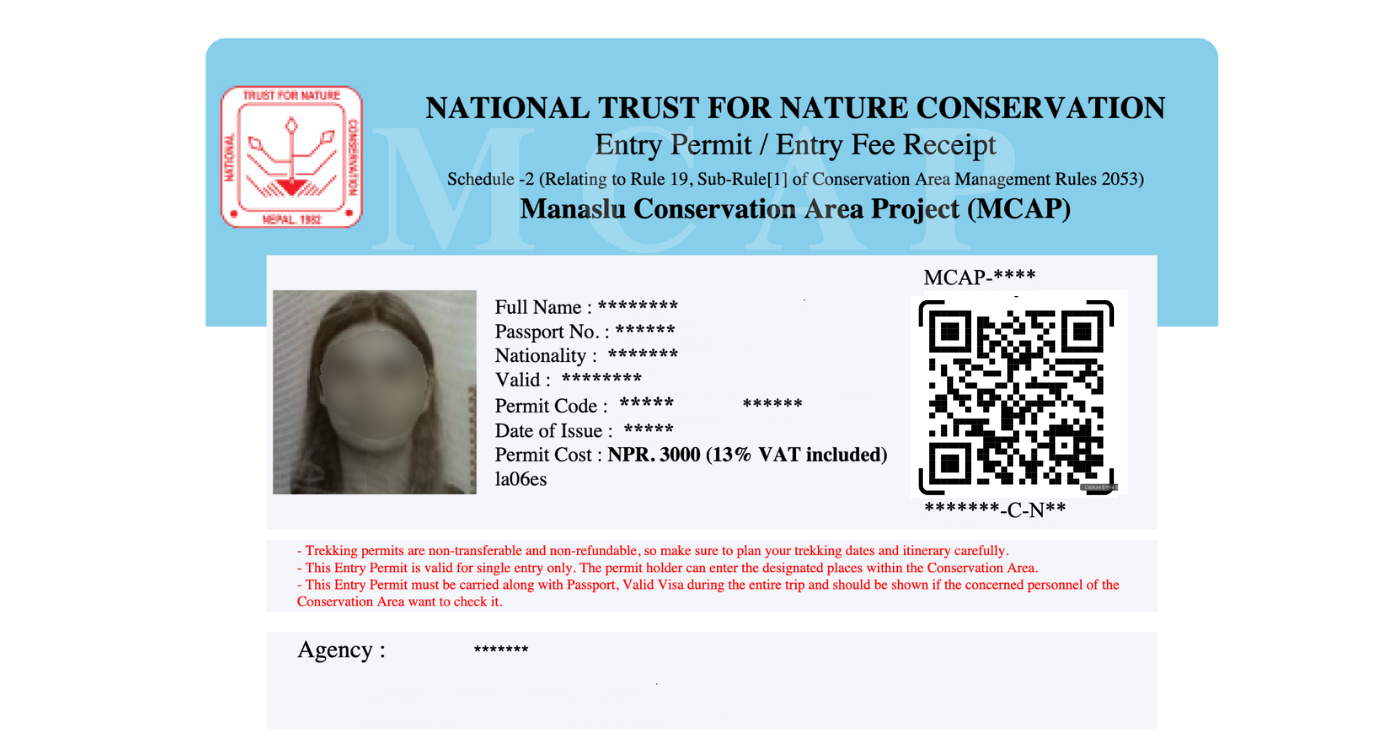
Annapurna Conservation Area Permit (ACAP)
Why is the ACAP required for the Manaslu trek?
Although the Manaslu Circuit begins in a different conservation zone, trekkers exit the route through Dharapani, which falls inside the Annapurna Conservation Area. To legally pass this section, the ACAP is mandatory.
How much does the ACAP cost?
| Nationality | Fee |
|---|---|
| Foreigners | NPR 3,000 (USD 30) |
| SAARC Nationals | NPR 1,000 (USD 10) |
| Nepali Citizens | NPR 100 |
Who issues the ACAP?
The ACAP is issued by the Nepal Tourism Board (NTB) in Kathmandu and Pokhara, as well as the NTB office in Besisahar, which is a gateway to the Annapurna region.
Where is the ACAP checked?
The ACAP is inspected and stamped at Dharapani, the point where trekkers transition from the Manaslu region into Annapurna. Without the ACAP, trekkers cannot legally continue past this checkpoint.
What documents are required for the ACAP?
- Original passport and Nepal visa
- Passport photocopies
- 1–2 passport-size photos
- Trekking itinerary (provided by your agency)
How long does it take to get the ACAP?
The ACAP is usually issued within 30 minutes to 1 hour at NTB offices. If arranged through a trekking agency, it is handled at the same time as the MRAP and MCAP.
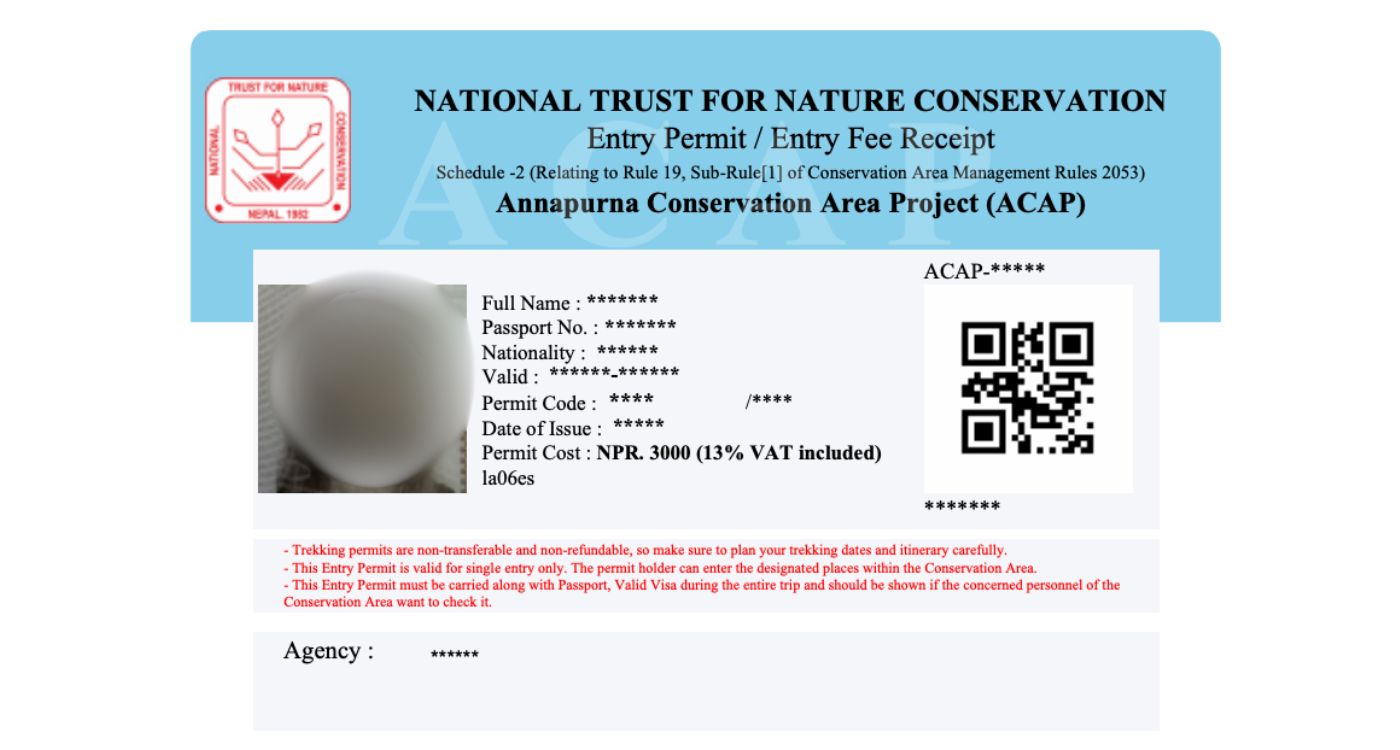
Additional Permits
Tsum Valley Restricted Permit
Which areas does the Tsum Valley Permit cover?
The Tsum Valley Restricted Permit allows entry into the culturally rich and remote northern section of the Manaslu region. Key areas covered include Lokpa, Chhekampar, Nile, and Mu Gompa, which are famous for monasteries, Tibetan-influenced villages, and sacred landscapes.
How much does the Tsum Valley Permit cost?
| Season | Fee Structure |
|---|---|
| September – November (Peak Season) | USD 40 for first 7 days + USD 7 per additional day |
| December – August (Off Season) | USD 30 for first 7 days + USD 7 per additional day |
Who issues the Tsum Valley Permit?
The permit is issued by the Department of Immigration in Kathmandu, and applications must be submitted through a registered trekking agency.
What documents are required for the Tsum Valley Permit?
- Original passport with valid Nepal visa
- Passport photocopies
- 2–4 passport-size photos
- Proof of travel insurance (high-altitude coverage recommended)
- Trekking itinerary including Tsum Valley extension
How long does it take to issue the permit?
When processed through a trekking agency, the Tsum Valley Permit is typically issued within the same day as the MRAP, provided all documents are complete.
Chumnubri Rural Municipality Permit
What is the Chumnubri Rural Municipality Permit?
This permit was introduced by the local government to support community development projects within the Chumnubri area of the Manaslu region. Funds from this permit are used for infrastructure, schools, and village improvements.
How much does it cost?
The fee is approximately USD 15 per trekker.
Who issues the Chumnubri Rural Municipality Permit?
This local permit is collected either through trekking agencies in Kathmandu or directly at village checkpoints within the Chumnubri area.
When is it required?
Every trekker entering the Chumnubri rural area, including those on the Manaslu Circuit or Tsum Valley extensions, must carry this permit in addition to RAP, MCAP, and ACAP.
TIMS Card
- Not required for Manaslu if you hold RAP.
- May be needed if extending the trek into non-restricted Annapurna routes.
Permit Costs (Complete Breakdown)
| Permit | Fee |
|---|---|
| RAP | USD 75–100 for the first 7 days, then USD 10–15 per extra day |
| MCAP | NPR 3,000 (USD 30) foreigners; NPR 1,000 SAARC |
| ACAP | NPR 3,000 (USD 30) foreigners; NPR 1,000 SAARC |
| Tsum Valley (Optional) | USD 30–40 for 7 days, then USD 7 per extra day |
| Example Duration | Total (No Tsum) | Total (With Tsum) |
|---|---|---|
| 14–16 day trek | USD 160–180 | USD 200–240 |
How to Obtain the Permits
- Who can apply: Only licensed trekking agencies. Individual trekkers cannot apply.
Where do we apply the permits from? Let’s make it transparent
- RAP: Department of Immigration, Kathmandu.
- MCAP & ACAP: NTB offices in Kathmandu, Pokhara, or Besisahar.
Required documents:
- Original passport + copies
- Nepal visa
- Four passport-size photos
- Travel insurance covering high-altitude evacuation
- Detailed trekking itinerary
Processing time: Same-day if complete; usually within one business day.
Practical note: Your agency handles all paperwork, fees, and office visits. Fees are included in the itinerary itself.
Permit Regulations & Rules
- Minimum group size: Two trekkers (excluding guide).
- No solo permits allowed.
- A licensed guide from a registered agency is mandatory.
- Children under 10: Exempt from fees but must still be listed.
- Permits are non-transferable, non-refundable, and single-entry only.
- Trekkers must carry permits at all times and present them at checkpoints.
- All trekking activity is governed by Nepal’s National Park and Wildlife Conservation Act.
Permit Checkpoints Along the Trail
- Jagat (first RAP entry)
- Philim and Namrung (RAP and MCAP inspections)
- Samagaun and Samdo (RAP checkpoints)
- Dharapani (ACAP exit check)
- Lokpa and Nile (for Tsum Valley trekkers)
Misconceptions & Clarifications
| Misconception | Clarification |
|---|---|
| Solo trekking is allowed with a higher fee. | Solo trekking is completely banned. RAP requires at least 2 trekkers plus a licensed guide. |
| TIMS card is compulsory everywhere. | Not for Manaslu. RAP replaces the TIMS card. |
| Permits can be bought online by trekkers. | RAP must be applied through a licensed agency in Kathmandu. |
| You only need one permit for Manaslu. | Three are mandatory: RAP, MCAP, and ACAP. |
| Children don’t need permits. | Under-10s don’t pay fees but must still be included in the application. |
| Permits can be refunded if the trek is canceled. | Permits are strictly non-refundable and non-transferable. |
| Checkpoints are not strict. | Permits are inspected and stamped at every major checkpoint. |
Common Questions (FAQs)
Can I trek solo?
No, solo trekking in the Manaslu region is not permitted under any condition. The government requires at least two trekkers plus a licensed guide for every permit application. This regulation is in place for safety, border security, and cultural protection. Even if you are experienced, Immigration will not issue the Restricted Area Permit (RAP) to a single traveler. Solo trekkers who want to do this trek can only join legally if an agency pairs their permit with another traveler’s application, and a guide is still mandatory.
Can I apply online myself?
No. Trekkers cannot apply for Manaslu permits directly online. The RAP must be processed by a registered trekking agency in Nepal through the Department of Immigration in Kathmandu. This rule ensures that all trekkers are traveling with licensed guides. MCAP and ACAP permits can technically be obtained individually from the Nepal Tourism Board, but in practice, most trekkers arrange all three permits together through their agency to avoid complications.
How long does it take to issue the permits?
If all documents are complete, permits are normally issued within a few hours when applied through an agency. However, during peak trekking seasons or national holidays like Dashain and Tihar, processing can take longer. For this reason, it is best to allow at least one full working day in Kathmandu to finalize all permits before starting your trek.
Can I get permits in advance before arriving in Nepal?
No. To apply for permits, you must present your original passport with a valid Nepal visa, which cannot be submitted until you are physically in Nepal. While agencies can prepare paperwork in advance with passport scans, the actual permits can only be finalized after you arrive and your original documents are verified by Immigration.
Do children need permits?
Yes. Children are required to have the same permits (RAP, MCAP, ACAP, etc.) as adults, even if they are under 10 years old. However, children under 10 are exempt from paying permit fees. Their details still need to be included on the group permit application, and parents should provide passport copies and photos for their children.
How many photos are required?
Trekkers should bring at least four recent passport-size photos. Two are used for permits, and the others serve as backups in case additional paperwork or trekking cards are required along the way. Some offices now accept digital photos, but it is always safer to carry printed copies.
What if my trek is longer than planned?
RAP permits are valid only for the exact number of days purchased. If your trek takes longer than expected, you cannot extend the RAP on the trail. Overstaying can result in fines or being stopped at checkpoints. This is why most agencies recommend adding 2–3 buffer days when applying, to cover weather delays, acclimatization, or health-related slowdowns.
Do I need a TIMS card for Manaslu?
No, a TIMS card is not required for the Manaslu Circuit if you have the RAP. The RAP serves as the primary registration document. However, if you extend your trek into the wider Annapurna region beyond Dharapani, a TIMS card may then be required.
Are permits refundable?
No. All permits for Manaslu, including RAP, MCAP, and ACAP, are non-refundable and non-transferable. If your trek is canceled, rescheduled, or cut short, you cannot recover the money spent on permits. This is why agencies often advise confirming your travel dates and insurance coverage before applying.
Conclusion Notes
The Manaslu region remains restricted because of its cultural sensitivity and proximity to the Tibetan border. Permit fees directly support conservation, community schools, health posts, and village development. Compared to Upper Mustang or Dolpo, Manaslu is moderately priced but more strictly regulated.
Looking ahead, Nepal may move toward digital permit systems, but for now, stamped paper permits are the only valid documents. Trekkers should respect these regulations, as they are what allow the Manaslu region to remain both accessible and protected for future generations.
Escape Himalaya - why ESCAPE with us?
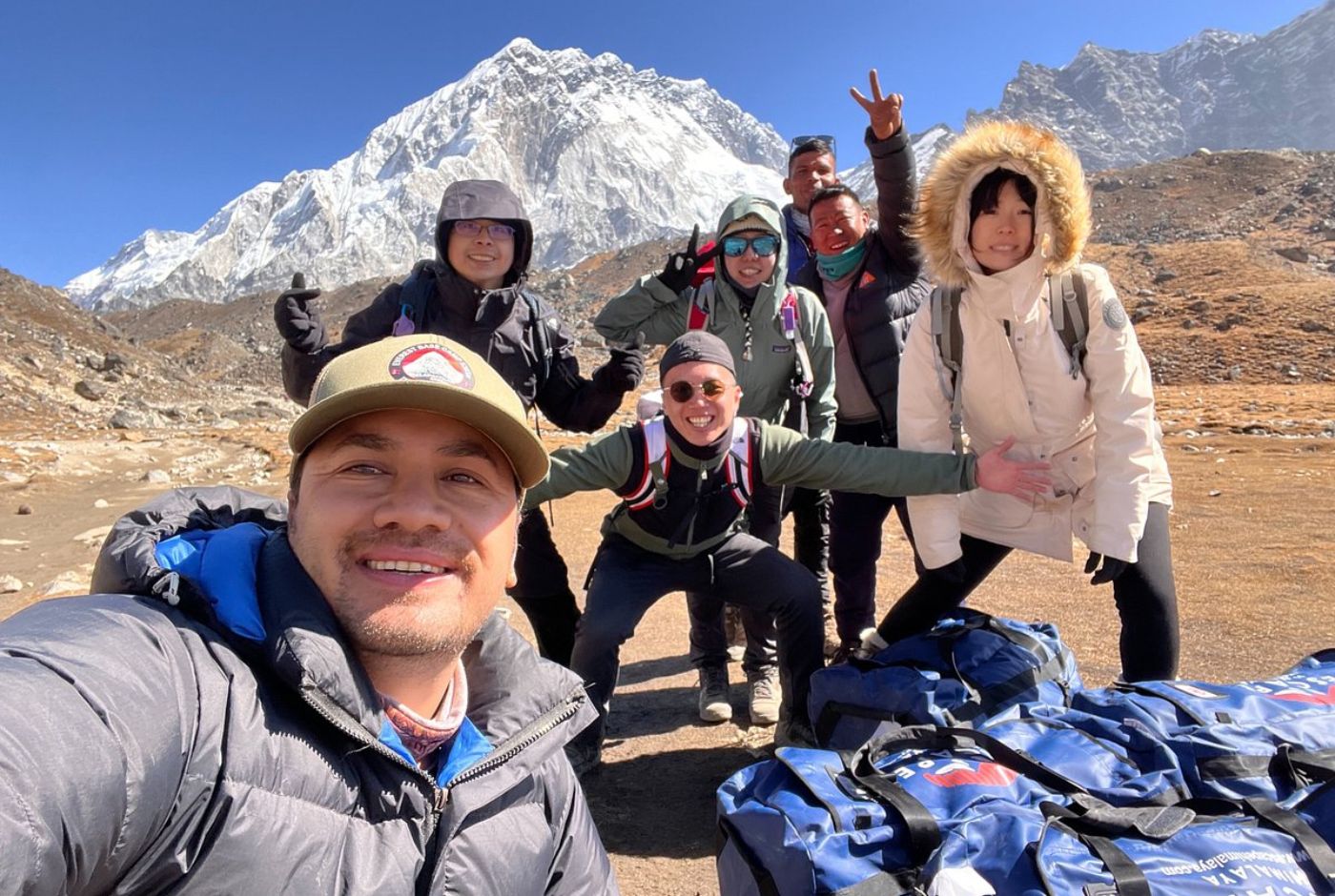
At Escape Himalaya, we operate all treks in the Manaslu region with the goal of making your journey effortless and worry-free.
As a local and authentic travel company based in Nepal, we bring over 15 years of experience in guiding adventurers through these remote trails.
Our team is always ready to answer your questions, provide reliable support, and ensure every detail of your trek is handled with care, so you can focus fully on experiencing the beauty of the Manaslu region.






